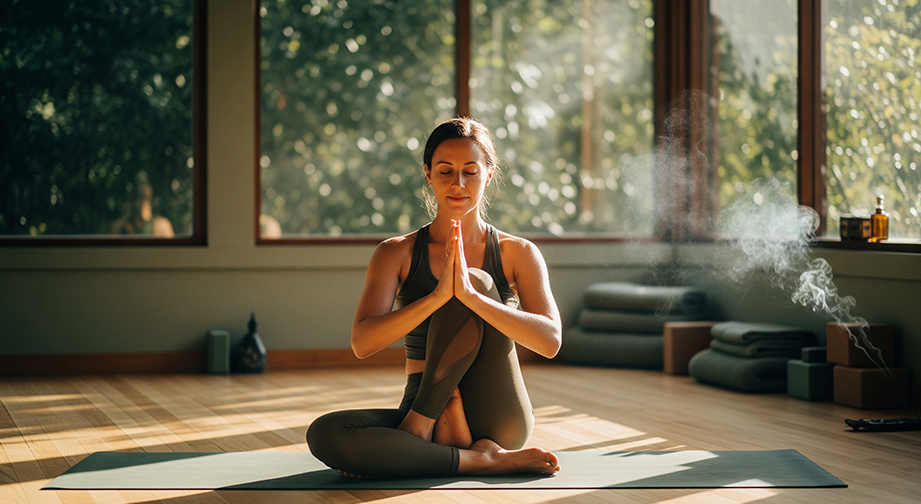Gorakshasana (Cowherd Gorakhnath's Pose): A Complete Guide
Introduction
Gorakshasana, also known as Cowherd Gorakhnath's Pose, is a unique seated yoga posture that offers a blend of grounding, balance, and inner calm. In Sanskrit, "Goraksha" means "protector of cows" or refers to the sage Gorakhnath, and "asana" means "pose" or "seat." The essence of this asana is balancing and calming—helping you find steadiness both in body and mind.
If you’ve ever felt stiff after sitting too long or wanted a gentle way to deepen your meditation practice, Gorakshasana can be your best friend. It’s accessible and soothing, especially for beginners seeking more flexibility and peace.
Step-by-Step Guide to Gorakshasana

- Begin Seated: Sit on your yoga mat with legs straight in front of you (Dandasana).
- Bend Your Knees: Slowly bend your knees and bring the soles of your feet together, similar to Butterfly Pose.
- Adjust the Heels: Carefully pull your feet closer to your pelvis. Now, gently place your heels so they slightly lift, aiming to stack the heels one above the other (if possible), keeping toes and knees pointing out.
- Find Balance: Place your hands on your knees or in your lap. Allow your sit bones (hips) to ground evenly.
- Lengthen the Spine: Inhale and sit up tall, lifting through the crown of your head.
- Settle in: Exhale, soften your shoulders, and gently close your eyes if comfortable.
- Breathe: Maintain a slow, steady breath—inhale deeply for a count of 4, exhale gently for a count of 4.
- Hold: Stay in Gorakshasana for 30 seconds to 2 minutes, focusing on your breath and sensations. Repeat for 1-3 rounds as needed.
Modifications for Beginners:
- Sit on a folded blanket or yoga block to ease hip tightness.
- If stacking heels is difficult, keep them side by side.
To Intensify:
- Fold forward gently from the hips for a deeper stretch.
- Bring hands into prayer at the heart (Anjali Mudra) or overhead for a challenge.
Alignment & Safety Tips
- Focus: Keep your spine tall and natural. Avoid rounding your back.
- Knees: Don’t force your knees down; let gravity help gradually.
- Heels: Stack gently, but don’t strain—comfort comes first.
- Breath: Use steady breathing to relax further into the pose.
- Common Mistakes:
- Slouching—remedy: Lengthen your spine on every inhale.
- Overexerting hips—remedy: Use props and take it slow.
- Safety Precautions:
- Avoid if you have recent knee, hip, or ankle injuries.
- Not recommended during pregnancy (advanced variation).
- Consult a yoga therapist if unsure about joint safety.
Benefits of Gorakshasana
Physical Benefits:
- Improves hip and groin flexibility
- Strengthens lower back and core muscles
- Promotes healthy posture and spinal alignment
- Opens chest and shoulders
Mental Benefits:
- Reduces anxiety and stress
- Invites a sense of calm and equilibrium
- Supports mindfulness and meditation
Energy & Chakra Connection:
- Stimulates Muladhara (Root) Chakra for grounding
- Connects to Svadhisthana (Sacral) Chakra—creativity & emotions
Contraindications
- Avoid if you have severe hip, knee, or ankle injuries.
- Pregnant practitioners should consult a doctor first.
- Avoid if you have extreme lower back pain or sciatica.
Alternatives:
- Easy Pose (Sukhasana) – less intense, still grounding.
- Bound Angle Pose (Baddha Konasana) – feet together, knees wide.
Beginner’s Tips & Variations
- Use a folded blanket, block, or bolster under your sit bones for better comfort.
- Support your knees with cushions if hips or groins feel tight.
- Gentle sway side to side to release tension.
Advanced Variations:
- Fold forward with a long spine, resting chest toward stacked heels.
- Try Khechari Mudra (yogic tongue lock) if you are experienced.
How to Include Gorakshasana in a Yoga Flow
- Best as a main seated practice or for meditation and breathwork.
- Gently opens hips after warming up with dynamic movements.
- Beautiful as a final meditation seat in your practice.
Pairs well with:
- Butterfly Pose (Baddha Konasana)
- Cat-Cow (Marjaryasana-Bitilasana)
- Seated Forward Fold (Paschimottanasana)
Mind-Body Connection
As you hold Gorakshasana, encourage mindful awareness of each inhale and exhale. Visualize stability flowing from your hips down into the earth. This pose is traditionally regarded as a meditative seat, said to awaken dormant energies or promote a sense of internal peace—making it special for both body and spirit.
Summary Box
- Asana Name: Gorakshasana (Cowherd Gorakhnath's Pose)
- Level: Beginner–Intermediate
- Focus Areas: Hips, Groin, Spine, Lower Back
- Duration: 30 seconds–2 minutes, 1–3 rounds
- Best Time to Practice: Morning or Evening
Frequently Asked Questions
Is Gorakshasana safe for everyone?
No, those with hip, knee, or ankle injuries, or severe back pain, should avoid or modify. Pregnant practitioners should seek medical advice first.
What if my hips are tight?
Prop yourself up on a blanket or block and support your knees to make the pose more comfortable.
Can I meditate in Gorakshasana?
Absolutely—this posture is traditionally used as a meditative seat!
How often should I practice this pose?
Start 2–3 times per week, gradually increasing as your body opens up.